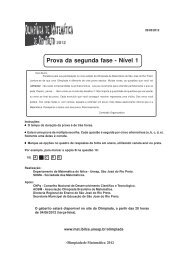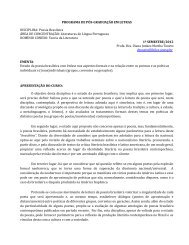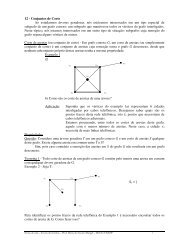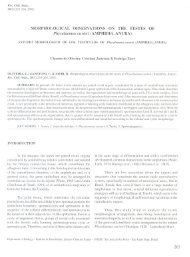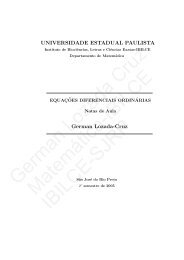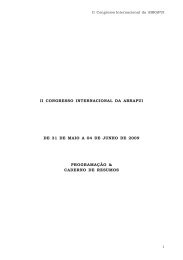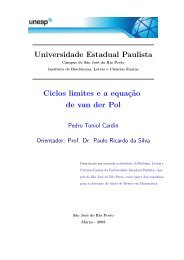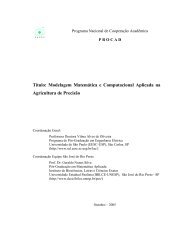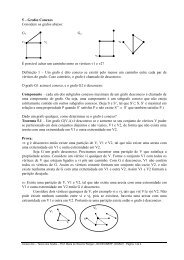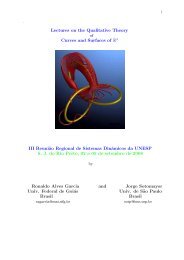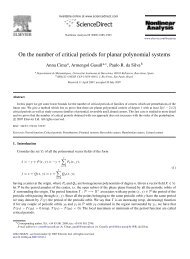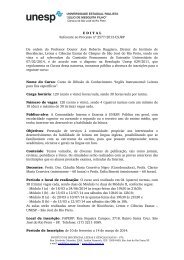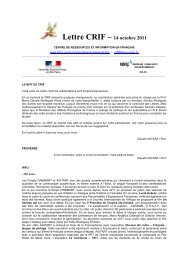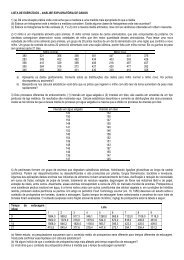Extremal Positive Trigonometric Polynomials - CiteSeerX
Extremal Positive Trigonometric Polynomials - CiteSeerX
Extremal Positive Trigonometric Polynomials - CiteSeerX
Create successful ePaper yourself
Turn your PDF publications into a flip-book with our unique Google optimized e-Paper software.
APPROXIMATION THEORY:<br />
A volume dedicated to Blagovest Sendov<br />
2002, 1-24<br />
<strong>Extremal</strong> <strong>Positive</strong> <strong>Trigonometric</strong> <strong>Polynomials</strong><br />
Dimitar K. Dimitrov ∗<br />
In this paper we review various results about nonnegative trigonometric<br />
polynomials. The emphasis is on their applications in Fourier<br />
Series, Approximation Theory, Function Theory and Number Theory.<br />
1. Introduction<br />
There are various reasons for the interest in the problem of constructing<br />
nonnegative trigonometric polynomials. Among them are: Cesàro means<br />
and Gibbs’ phenomenon of the the Fourier series, approximation theory,<br />
univalent functions and polynomials, positive Jacobi polynomial sums, orthogonal<br />
polynomials on the unit circle, zero-free regions for the Riemann<br />
zeta-function, just to mention a few.<br />
In this paper we summarize some of the recent results on nonnegative<br />
trigonometric polynomials. Needless to say, we shall not be able to cover all<br />
the results and applications. Because of that this short review represents<br />
our personal taste. We restrict ourselves to the results and problems we<br />
find interesting and challenging.<br />
One of the earliest examples of nonnegative trigonometric series is the<br />
Poisson kernel<br />
∞∑<br />
1 + 2 ρ k 1 − ρ 2<br />
cos kθ =<br />
, −1 < ρ < 1, (1.1)<br />
1 − 2ρ cos θ + ρ2 k=1<br />
which, as it was pointed out by Askey and Gasper [8], was also found but<br />
not published by Gauss [30]. The problem of constructing nonnegative<br />
trigonometric polynomials was inspired by the development of the theory<br />
∗ Research supported by the Brazilian science foundation FAPESP under Grant No.<br />
97/06280-0 and CNPq under Grant No. 300645/95-3
2 <strong>Positive</strong> <strong>Trigonometric</strong> <strong>Polynomials</strong><br />
of Fourier series and by the efforts for giving a simple proof of the Prime<br />
Number Theorem. This area of research reached its efflorescence in the<br />
beginning of the twentieth century due to the efforts of many celebrated<br />
mathematicians.<br />
2. Fourier Series<br />
Let ρ to tend to one in (1.1). We obtain the formal Fourier series<br />
∞∑<br />
1 + 2 cos kθ (2.2)<br />
k=1<br />
of the Dirac delta function δ(θ). Now Poisson’s formula<br />
f(ρe iθ ) = 1<br />
2π<br />
∫ π<br />
−π<br />
f(e iϕ 1 − ρ 2<br />
)<br />
dϕ (2.3)<br />
1 − 2ρ cos(θ − ϕ) + ρ2 and the theory of generalized functions strongly suggest that some sufficiently<br />
“good” functions can be recovered by its convolutions with certain<br />
kernels. It is already known what “good” and ”certain” means but it was<br />
not so in the beginning of the nineteenth century, for instance, when Poisson<br />
himself, using his formula (2.3), produced a faulty convergence proof<br />
for Fourier series.<br />
Let us concentrate on the properties of the kernels. It is intuitively<br />
clear from the above observation that these must inherit some of the properties<br />
of the Poisson kernel and of the Dirac delta functions. Then an even<br />
positive kernel is any sequence {k n (θ)} of even, nonnegative continuous 2πperiodic<br />
functions if k n (θ) are normalized by (1/2π) ∫ π<br />
−π k n(θ)dθ = 1 and<br />
they converge uniformly to zero in any closed subset of (0, 2π). Nowadays<br />
it is known that the convolutions<br />
K n (f, x) = k n ∗ f(x) = 1<br />
2π<br />
∫ π<br />
−π<br />
k n (θ)f(x − θ)dθ<br />
of such kernels converge in L p [−π, π], 1 ≤ p ≤ ∞, (p = ∞ means, of course,<br />
uniformly), almost everywhere and in mean provided the function f(x) is<br />
2π-periodic and belongs to an adequate space of functions (see [38]). More<br />
precisely, f ∈ L p [−π, π] yields the L p convergence, the requirements that<br />
f(x) is integrable in [−π, π] guarantees the almost everywhere convergence,<br />
and when, in addition to the integrability of f(x), for x ∈ [−π, π], the limit<br />
lim h→0 (f(x + h) + f(x − h)) exists, then<br />
K n (f; x) −→ (1/2) lim<br />
h→0<br />
(f(x + h) + f(x − h))<br />
as n diverges.
Dimitar K. Dimitrov 3<br />
To the best of our knowledge, Fejér [22] was the first to realize the above<br />
facts in 1900. He proved that the cosine polynomials<br />
F n (θ) = 1 + 2<br />
n∑<br />
k=1<br />
are nonnegative establishing the simple closed form<br />
(<br />
1 − k )<br />
cos kθ (2.4)<br />
n + 1<br />
F n (θ) = sin2 (n + 1)θ/2<br />
(n + 1) sin 2 θ/2 .<br />
This immediately yields that {F n (θ)} is a summability kernel. It is known<br />
that the corresponding convolutions<br />
F n (f; x) = 1<br />
2π<br />
∫ π<br />
−π<br />
f(x − θ)F n (θ)dθ<br />
coincide with the Cesàro means of the Fourier series of f(x),<br />
F n (f; x) = σ n (f; x) = S 0(f; x) + · · · + S n (f; x)<br />
.<br />
n + 1<br />
Here S n (f; x) denotes the n-th partial sum of the Fourier series of f(x).<br />
Another reason for which Fejér was interested in nonnegative trigonometric<br />
sums is the Gibbs’ phenomenon, called also the Gibbs-Wilbraham<br />
phenomenon. We refer the reader to Zygmund’s classical book [63, Chapter<br />
II, §9] and a nice review paper of E. Hewitt and R. E. Hewitt [34] for<br />
more information about this topic. Fejér’s interest led him to conjecture<br />
in 1910 that the partial sums ∑ n<br />
k=1<br />
(1/k) sin kθ of the sine Fourier series of<br />
(π − θ)/2, 0 < θ < π, extended as an odd function, are positive in (0, π).<br />
Jackson [35] and Gronwall [33] proved Fejér’s conjecture independently,<br />
but only within a few months. Nowadays the inequality<br />
n∑<br />
k=1<br />
sin kθ<br />
k<br />
> 0 for θ ∈ (0, π) (2.5)<br />
is called the Fejér-Jackson-Gronwall inequality.<br />
In 1953 Turán [59] established the following important fact:<br />
Theorem 1. If<br />
n∑<br />
b k sin(2k − 1)θ ≥ 0, θ ∈ (0, π),<br />
k=1
4 <strong>Positive</strong> <strong>Trigonometric</strong> <strong>Polynomials</strong><br />
then<br />
n∑ b k<br />
k<br />
k=1<br />
sin kθ > 0 θ ∈ (0, π).<br />
This theorem immediately yields the Fejér-Jackson-Gronwall inequality because<br />
it is very easy to prove that ∑ n<br />
k=1<br />
sin(2k − 1)θ ≥ 0 for θ ∈ (0, π).<br />
Recently Turán’s result was used in [19] to provide some new nonnegative<br />
sine polynomials<br />
and<br />
Theorem 2. The sine polynomials<br />
n∑<br />
( 1<br />
k − k − 1 )<br />
sin kθ, (2.6)<br />
n(n + 1)<br />
k=1<br />
n∑<br />
( 1<br />
k<br />
k=1<br />
n∑<br />
k=1<br />
are non-negative in (0, π).<br />
)<br />
2(k − 1)<br />
−<br />
n 2 sin kθ, (2.7)<br />
− 1<br />
1<br />
1<br />
sin kθ − sin nθ,<br />
k 2n<br />
The graphs of the polynomials (2.6) and (2.7) show that their Gibb’s<br />
phenomenon is much smaller than the Gibb’s phenomenon of Fejér-Jackson-<br />
Gronwall’s polynomials. Moreover, (2.6) and (2.7) approximate the function<br />
(π −θ)/2 uniformly on every compact subset of (0, π] much better than<br />
(2.5) does.<br />
There are still many interesting nonnegative trigonometric polynomials<br />
which are related to Fourier series but we shall stop here in order to recall<br />
some well-known results concerning a general approach to obtaining such<br />
polynomials and review some of the interesting examples.<br />
3. Construction of positive trigonometric polynomials<br />
Fejér and Riesz (see Fejér’s paper [24] of 1915) proved the following representation<br />
of nonnegative trigonometric polynomials: For every non-negative<br />
trigonometric polynomial T (θ),<br />
T (θ) = a 0 +<br />
n∑<br />
(a k cos kθ + b k sin kθ),<br />
k=1
Dimitar K. Dimitrov 5<br />
there exists an algebraic polynomial R(z) = ∑ n<br />
k=0 c kz k of degree n such<br />
that T (θ) = |R(e iθ )| 2 . Conversely, for every algebraic polynomial R(z) of<br />
degree n, the polynomial |R(e iθ )| 2 is a nonnegative trigonometric polynomial<br />
of order n.<br />
An equivalent form of the Fejér-Riesz representation is:<br />
Theorem 3. The trigonometric polynomial<br />
T (θ) = a 0 +<br />
n∑<br />
(a k cos kθ + b k sin kθ)<br />
k=1<br />
of order n is nonnegative for every real θ if and only if there exist complex<br />
numbers c k , k = 0, 1, . . . , n, such that<br />
a 0 =<br />
n∑<br />
k=0<br />
n−k<br />
∑<br />
|c k | 2 , a k − ib k = 2 c k+ν¯c ν , for k = 1, . . . , n.<br />
ν=0<br />
Szegő [55] observed that in the Fejér-Riesz’s representation of the nonnegative<br />
cosine polynomials the parameters c k can be chosen to be real<br />
Theorem 4. Let<br />
C n (θ) = a 0 /2 +<br />
n∑<br />
a k cos kθ<br />
be a cosine polynomial of order n which is nonnegative for every real θ.<br />
Then there exists an algebraic polynomial with real coefficients R(z) =<br />
∑ n<br />
k=0 c kz k of degree n such that T (θ) = |R(e iθ )| 2 . Thus, the cosine polynomial<br />
C n (θ) of order n is nonnegative if and only if there exist real numbers<br />
c k , k = 0, 1, . . . , n, such that<br />
a 0 =<br />
a k =<br />
n∑<br />
c 2 k,<br />
k=0<br />
n−k<br />
k=1<br />
∑<br />
c k+ν c ν for k = 1, . . . , n.<br />
ν=0<br />
The corresponding Fejér-Riesz type representation of the nonnegative<br />
sine polynomials was obtained recently in [19] and reads as follows:<br />
Theorem 5. The sine polynomial of order n<br />
S n (θ) =<br />
n∑<br />
b k sin kθ<br />
k=1
6 <strong>Positive</strong> <strong>Trigonometric</strong> <strong>Polynomials</strong><br />
is nonnegative if and only if there exist real numbers d 0 , . . . , d n−1 , such that<br />
b 1 =<br />
b k =<br />
n−1<br />
∑<br />
d 2 k,<br />
k=0<br />
n−k<br />
∑<br />
ν=0<br />
n−k−2<br />
∑<br />
c k+ν−1 c ν −<br />
b n−1 = c 0 c n−2 + c 1 c n−1 ,<br />
b n = c 0 c n−1 ,<br />
ν=0<br />
c k+ν+1 c ν , for k = 2, . . . , n − 2,<br />
where the parameters c are represented in terms of the parameters d by<br />
c k = ([k/2] + 1)<br />
[n/2]−[k/2]−(n,2)(k,2)<br />
∑<br />
ν=0<br />
√<br />
2<br />
([k/2] + ν + 1)([k/2] + ν + 2) d k+2ν,<br />
where [s] denotes the integer part of s, and (s, 2) is the rest of the division<br />
of s by 2.<br />
4. Some extremal positive trigonometric polynomials<br />
Fejér-Riesz’ type representations (see Theorems 3, 4 and 5 above) show<br />
that a variety of nonnegative trigonometric polynomials can be obtained by<br />
setting different values for the parameters c k . However, the most natural<br />
and beautiful examples arise as solutions of some extremal problems for the<br />
coefficients of T (θ). For example, it is easily seen that Fejér’s kernel (2.4)<br />
is the only solution of the extremal problem<br />
max{a 1 + · · · + a n : 1 + 2<br />
n∑<br />
a k cos kθ ≥ 0}.<br />
Indeed, using the Fejér-Riesz representation for cosine polynomials, the<br />
above result is equivalent to the inequality between the arithmetic and the<br />
square means of the corresponding parametric sequence.<br />
In 1915 Fejér [24] determined the maximum of √ a 2 1 + b2 1 provided T (θ)<br />
is nonnegative and a 0 = 1. He showed that<br />
√<br />
a 2 1 + b2 1 ≤ 2 cos(π/(n + 2)) (4.8)<br />
and that this bound is sharp.<br />
k=1
Dimitar K. Dimitrov 7<br />
Szegő [54], in 1926, and independently Egerváry and Szász [21], in 1928,<br />
extended Fejér’s result (4.8), finding estimates for the means √ a 2 k + b2 k ,<br />
for k = 1, 2, . . . , n, of nonnegative trigonometric polynomials, subject to<br />
a 0 = 1. More precisely, they proved that<br />
Theorem 6. If<br />
T (θ) = 1 +<br />
n∑<br />
(a k cos kθ + b k sin kθ)<br />
k=1<br />
is nonnegative , then for any k, 1 ≤ k ≤ n,<br />
√<br />
a 2 k + b2 k ≤ 2 cos π<br />
[n/k] + 2 .<br />
Moreover, equality is attained if and only if T (θ) is of the form<br />
τ(θ)<br />
{<br />
1 + 2<br />
p + 2<br />
p∑<br />
ν=1<br />
(<br />
(p − ν + 1) cos να +<br />
)<br />
}<br />
sin(ν + 1)α<br />
cos(νk(θ − ψ)) ,<br />
sin α<br />
where τ is an arbitrary nonnegative trigonometric polynomial of order q,<br />
α = π/(p + 2), p = [n/k], n = pk + q, (0 ≤ q < k) and ψ is an arbitrary<br />
constant.<br />
In particular, one obtains, for any k, 1 ≤ k ≤ n, the sharp estimates<br />
|a k | ≤ cos<br />
π<br />
[n/k] + 2<br />
for the coefficients of the nonnegative cosine polynomial<br />
n<br />
1<br />
2 + ∑<br />
a k cos kθ.<br />
k=1<br />
It was pointed out in [19] that the nonnegative sine polynomial<br />
m∑<br />
k=0<br />
sin(2k + 1)θ = sin2 ((m + 1)θ)<br />
,<br />
sin θ<br />
which is a multiple of Fejér’s kernel, turns out to be the only sine polynomial<br />
of odd order 2m + 1 with coefficient 1 of sin θ for which the maximum of<br />
the moment b n , n = 2m + 1, is attained.
8 <strong>Positive</strong> <strong>Trigonometric</strong> <strong>Polynomials</strong><br />
There are only a few results about nonnegative sine polynomials with<br />
extremal coefficients. Since sine polynomials are odd functions, in what<br />
follows we shall call<br />
n∑<br />
S n (θ) = sin kθ<br />
k=1<br />
a nonnegative sine polynomial if S n (θ) ≥ 0 for every θ ∈ [0, π].<br />
In 1950 Rogosinski and Szegő [51] observed that, if S n (θ) is non-negative,<br />
then b 1 ≥ 0 and b 1 = 0 if and only if S n is identically zero and considered<br />
the following extremal problem for nonnegative sine polynomials:<br />
Problem 1. Determine the minimum and maximum values of b k provided<br />
the sine polynomial S n (θ) is in<br />
{<br />
}<br />
n∑<br />
S n = S n (θ) = sin θ + b k sin kθ : S n (θ) ≥ 0 f or θ ∈ [0, π] .<br />
k=2<br />
For each of these values, find the extremal sine polynomial which belongs<br />
to S n and whose coefficient b k coincides with the corresponding extremal<br />
value.<br />
Rogosinski and Szegő suggested two methods for obtaining the extrema<br />
of the moments b k and found the minimal and maximal values of b 2 , b 3 , b n−1<br />
and b n . More precisely, these limits are:<br />
{ 2 cos(2π/(n + 3)), n odd,<br />
|b 2 | ≤<br />
2 cos θ 0 , n even,<br />
where θ 0 is the smallest zero of the function<br />
(n + 4) sin((n + 2)θ/2) + (n + 2) sin((n + 4)θ/2);<br />
|b 3 − 1| ≤ 2 cos<br />
1 − 2 cos θ 1 ≤ b 3 ≤ 1 + 2 cos<br />
b k<br />
π<br />
[(n − 1)/2] + 3 ,<br />
π<br />
[(n − 1)/2] + 3 ,<br />
where θ 1 is the smallest zero of the function<br />
([ n − 1 ([(n − 1)/2] + 2)θ<br />
] + 4) cos<br />
2<br />
2<br />
+ ([ n − 1 ] + 2) sin<br />
2<br />
|b n−1 | ≤ 1, n odd,<br />
−(n − 2)/(n + 2) ≤ b n−1 ≤ 1, n even;<br />
[(n − 1)/2] even,<br />
[(n − 1)/2] odd,<br />
([(n − 1)/2] + 4)θ<br />
;<br />
2
Dimitar K. Dimitrov 9<br />
and<br />
−(n − 1)/(n + 3) ≤ b n ≤ 1, n odd,<br />
|b n | ≤ n/(n + 2), n even.<br />
However, in none of the cases the corresponding extremal sine polynomials<br />
were determined explicitly. The method suggested in [19] allowed us<br />
to obtain the extremal sine polynomials in various cases. Here are some of<br />
the results obtained in [19]:<br />
Theorem 7. Let n = 2m + 2 be an even positive integer. Then for<br />
every S n (θ) ∈ S n<br />
(i)<br />
− m + 1<br />
m + 2 ≤ b n ≤ m + 1<br />
m + 2 .<br />
The equality b n = (m + 1)/(m + 2) is attained only for the nonnegative sine<br />
polynomial<br />
m∑<br />
( (m + k + 2)(m − k + 1)<br />
(k + 1) 2<br />
)<br />
sin(2k + 1)θ +<br />
(m + 1)(m + 2)<br />
(m + 1)(m + 2) sin(2k + 2)θ .<br />
k=0<br />
The equality b n = −(m + 1)/(m + 2) is attained only for the nonnegative<br />
sine polynomial<br />
m∑<br />
( (m + k + 2)(m − k + 1)<br />
(k + 1) 2<br />
)<br />
sin(2k + 1)θ −<br />
(m + 1)(m + 2)<br />
(m + 1)(m + 2) sin(2k + 2)θ .<br />
k=0<br />
(ii)<br />
−<br />
m<br />
m + 2 ≤ b n−1 ≤ 1.<br />
The equality b n−1 = 1 is attained only for the nonnegative sine polynomials<br />
sin θ +<br />
m∑<br />
(2pq sin 2kθ + sin(2k + 1)θ) + pq sin(2m + 2)θ,<br />
k=1<br />
where the parameters p and q satisfy p 2 + q 2 = 1.<br />
The equality b n−1 = −m/(m + 2) is attained only for the nonnegative sine<br />
polynomials<br />
sin θ +<br />
+<br />
−<br />
m∑<br />
k=1<br />
m∑<br />
k=1<br />
(<br />
2pq 1 −<br />
(<br />
1 −<br />
2k 2<br />
m(m + 2)<br />
2k(k + 1)<br />
m(m + 2)<br />
pq sin(2m + 2)θ,<br />
)<br />
sin 2kθ<br />
)<br />
sin(2k + 1)θ
10 <strong>Positive</strong> <strong>Trigonometric</strong> <strong>Polynomials</strong><br />
where p and q satisfy the relation p 2 + q 2 = 1.<br />
Theorem 8. Let n = 2m+1 be an odd positive integer. Then for every<br />
S n (θ) ∈ S n<br />
(i)<br />
−m<br />
m + 2 ≤ b n ≤ 1.<br />
The equality b n = 1 is attained only for the nonnegative sine polynomial<br />
m∑<br />
sin(2k + 1)θ.<br />
k=0<br />
The equality b n = −m/(m + 2) is attained only for<br />
(ii)<br />
m∑<br />
k=0<br />
(<br />
)<br />
2k(k + 1)<br />
(1 −<br />
m(m + 2) ) sin(2k + 1)θ .<br />
−1 ≤ b n−1 ≤ 1.<br />
The equality b n−1 = 1 is attained only for the nonnegative sine polynomial<br />
2m∑<br />
k=1<br />
sin kθ + 1 sin(2m + 1)θ.<br />
2<br />
The equality b n−1 = −1 is attained only for the nonnegative sine polynomial<br />
2m∑<br />
k=1<br />
(−1) k+1 sin kθ + 1 sin(2m + 1)θ.<br />
2<br />
In the same paper [51] of 1950 Rogosinski and Szegő found the highest<br />
possible derivative of the nonnegative sine polynomials at the origin. They<br />
proved that<br />
s ′ n(0) = 1+2b 2 +· · ·+nb n ≤<br />
{ n(n + 2)(n + 4)/24, n even,<br />
(n + 1)(n + 2)(n + 3)/24, n odd,<br />
(4.9)<br />
provided b k are the coefficients of a sine polynomial s n (θ) in the space<br />
S n . The sine polynomials for which the above limits are attained were not<br />
determined explicitly. It was done recently in [2], where the main result<br />
reads as:
Dimitar K. Dimitrov 11<br />
Theorem 9. The inequality (4.9) holds for every s n (θ) ∈ S n . Moreover,<br />
if n = 2m + 2 is even, then the equality S ′ 2m+2(0) = (m + 1)(m +<br />
2)(m + 3)/3 is attained only for the nonnegative sine polynomial<br />
S 2m+2 (θ) =<br />
m∑<br />
{(<br />
1 − k<br />
m + 1<br />
k=0<br />
+(k + 1)<br />
(<br />
1 − k<br />
m + 1<br />
) (<br />
1 − k<br />
) (<br />
2k + 1 +<br />
)<br />
k(k − 1)<br />
m + 3<br />
m + 2<br />
) (<br />
2 − k + 3<br />
m + 2 − k(k + 1)<br />
(m + 2)(m + 3)<br />
sin(2k + 1)θ<br />
)<br />
sin(2k + 2)θ<br />
and, if n = 2m+1 is odd, the equality S ′ 2m+1(0) = (m+1)(m+2)(2m+3)/6<br />
is attained only for the nonnegative sine polynomial<br />
S 2m+1 (θ) =<br />
m∑<br />
{(<br />
1 − k ) (<br />
)<br />
k(k + 2) k(k + 1)(2k + 1)<br />
1 + 2k − − sin(2k + 1)θ<br />
m + 1<br />
m + 2 (m + 2)(2m + 3)<br />
k=0 (<br />
+2(k + 1) 1 − k ) (<br />
1 − k + 2 ) (<br />
1 + k + 1 )<br />
}<br />
sin(2k + 2)θ .<br />
m + 1 m + 2 2m + 3<br />
The method developed in [19, 2] permitted the construction of various<br />
nonnegative cosine polynomials. Some of the interesting ones, obtained in<br />
[19], are:<br />
1 + 2<br />
1 + 2<br />
n∑<br />
k=1<br />
n∑<br />
k=1<br />
(<br />
1 − k ) (<br />
1 −<br />
n + 1<br />
}<br />
,<br />
)<br />
2k(n + k + 1)<br />
cos kθ, (4.10)<br />
n(n + 2)<br />
(<br />
1 − k ) (<br />
1 − k ) (<br />
1 + k )<br />
cos kθ, (4.11)<br />
n + 1 n + 2 2n + 3<br />
n−1<br />
∑<br />
(<br />
1 + 2 1 − k + 1 )<br />
cos(k + 1)θ. (4.12)<br />
n + 1/2<br />
k=1<br />
Sufficient conditions in terms of the coefficients in order that sine and<br />
cosine polynomial are positive were given by Vietoris [61] in 1958. He<br />
proved that<br />
n∑<br />
a k cos kθ > 0, 0 < θ < π,<br />
and<br />
k=1<br />
n∑<br />
a k sin kθ > 0, 0 < θ < π,<br />
k=1<br />
whenever a 0 ≥ a 1 ≥ . . . ≥ a n > 0 and 2ka k ≤ (2k − 1)a 2k−1 . Askey and<br />
Steinig [9] provided a simpler proof of this result.
12 <strong>Positive</strong> <strong>Trigonometric</strong> <strong>Polynomials</strong><br />
5. Approximation Theory<br />
Since this volume is designed to experts in Approximation Theory, we outline<br />
only the principal application of the positive trigonometric polynomials<br />
to this area and pose an open problem.<br />
The short discussion in Section 2 shows that the clue for constricting<br />
a very good explicit approximation tool for the 2π-periodic function is to<br />
find a “good” positive summability kernel. It was already mentioned in the<br />
beginning of the previous section that the most famous of the kernels, the<br />
Fejér’s one, obeys certain extremal properties.<br />
In 1912 Jackson [36, 37] proved his celebrated approximation result:<br />
Theorem 10. Let<br />
J n (θ) = α n F 2 n(θ),<br />
where α n is chosen in such a way that (1/2π) ∫ π<br />
−π J n(θ)dθ = 1. Then there<br />
exists a constant C, such that, for any f ∈ C[−π, π] which is 2π-periodic,<br />
‖f − J n ∗ f‖ ∞ ≤ Cω(f; 1/n),<br />
where ‖ ‖ ∞ is the uniform norm in [−π, π] and ω(f; δ) denotes the modulus<br />
of continuity of f(x) in the same interval.<br />
Bernstein [10] (see also [58, Chapter 6]) proved that ω(f; 1/n) is the best<br />
possible rate of uniform approximation of continuous functions by trigonometric<br />
polynomials of order n.<br />
There are different ways of proving Jackson’s approximation. We are<br />
interested mainly in the constructive one. A nice simple proof of Jackson’s<br />
theorem was given in Korovkin’s [41] and Rivlin’s [49, Chapter I] books. It<br />
uses essentially Fejér’s result about the extremal nonnegative cosine polynomial<br />
of the form<br />
n∑<br />
1 + 2 a k cos kθ,<br />
k=1<br />
whose coefficient a 1 is the largest possible, i.e. the cosine polynomial for<br />
which the equality in (4.8) is attained. It was mentioned in the previous<br />
section that Fejér’s kernel is the nonnegative cosine polynomial of the above<br />
form whose sum of the coefficients is the largest possible. The nonnegative<br />
cosine sums (4.10), (4.11) and (4.12) also appeared as a consequence of the<br />
solution of some extremal problems concerning the coefficients of sine polynomials.<br />
It was proved in [19] that they are positive summability kernels.<br />
It would be of interest to find the best one.
Dimitar K. Dimitrov 13<br />
Problem 2. Denote by K the set of all positive summability kernels<br />
{k n (θ)} ∞ n=0 and let<br />
˜C = {f ∈ C[−π, π] :<br />
f(−π) = f(π), f(t) ≠ const.}.<br />
Determine<br />
inf<br />
k n∈K<br />
sup<br />
f∈ ˜C<br />
sup<br />
n∈IN<br />
‖f − k n ∗ f‖ ∞<br />
ω(f, 1/n)<br />
and the positive summability kernel for which the infimum is attained.<br />
This problem might be called the problem about the best Jackson’s constant<br />
for approximation by convolutions. It is worth mentioning that the smallest<br />
value of the constant in the Jackson inequality for approximation of periodic<br />
functions was found by Korneichuk [39] (see also [40]). Denote by E n (f) the<br />
best approximation of the function f(θ) ∈ ˜C by trigonometric polynomials<br />
of order n, namely<br />
E n (f) = inf τ∈Tn ‖f − τ‖,<br />
where T n is the set of the trigonometric polynomials of order n. Korneichuk<br />
proved in [39] that the smallest value of the of the constant M, independent<br />
of f ∈ ˜C and n ∈ IN, for which the inequalities<br />
E n (f) ≤ Mω(f; π/(n + 1)), f(θ) ∈ ˜C n = 1, 2, . . . ,<br />
hold, is equal to 1. However, Problem 2 could be of interest on its own. The<br />
corresponding general question about the smallest value of the constant in<br />
Jackson’s theorem for approximation by algebraic polynomials is one of the<br />
most challenging open problems in Approximation Theory. The approach<br />
suggested by Bojanov [12, 13] seems to trace a promising path towards<br />
solving this classical enigma.<br />
6. Univalent functions and polynomials<br />
In 1915 Alexander [1] proved that the polynomials<br />
n∑<br />
k=1<br />
a k<br />
z k<br />
k<br />
and<br />
n∑<br />
k=1<br />
a 2k−1<br />
z 2k−1<br />
2k − 1
14 <strong>Positive</strong> <strong>Trigonometric</strong> <strong>Polynomials</strong><br />
are univalent in the unit disc of the complex plane provided a 1 ≥ · · · ≥<br />
a n > 0.<br />
In 1931 Dieudoneé [18] revealed the connection between Alexander’s<br />
result and Fejér-Jackson-Gronwall’s inequality. He proved that the polynomial<br />
n∑<br />
a k z k<br />
k=1<br />
is univalent in the unit disc if and only if<br />
n∑<br />
k=1<br />
k−1 sin kθ<br />
a k z ≠ 0 for |z| < 1, 0 ≤ θ ≤ π.<br />
sin θ<br />
In two consecutive papers, [25] of 1934, and [26] of 1936, Fejér extended<br />
the ideas of Alexander initiating the study of the so-called “vertically<br />
convex” functions. His approach provides one more connection between<br />
nonnegative trigonometric polynomials and univalent algebraic polynomials.<br />
This idea appeared in its final form in a joint paper of Fejér and<br />
Szegő [27] in 1951. The main result there states that an analytic function<br />
f(z) = u(z) + iv(z) with real Maclaurin coefficients is univalent in the unit<br />
disc if ∂u(θ)/∂θ ≤ 0 for 0 ≤ θ ≤ π.<br />
Another result which related positive trigonometric polynomials and<br />
univalent functions was obtained by Pólya and Schoenberg [47] in 1958.<br />
Before we formulate it, recall that the function f(z) = ∑ ∞<br />
k=0 a kz k is called<br />
convex in the unit disc D = {z : |z| < 1} if the image of D under f(z) is<br />
a convex set. Pólya and Schoenberg proved that, if f(z) is univalent and<br />
convex in D, then for any n ∈ IN, the polynomial<br />
p n (z) = 1<br />
2π<br />
is also convex, where<br />
∫ 2π<br />
0<br />
V n (θ) = 1 + 2<br />
V n (θ − ξ)f(re iξ )dξ, z = re iθ ,<br />
n∑<br />
k=1<br />
(n!) 2<br />
(n − k)!(n + k)! cos(kθ) ≥ 0<br />
is the de la Vallée Poussin kernel.<br />
We refer to the recent nice survey of Gluchoff and Hartmann [31], for<br />
these and other interesting results on the interplay of univalent functions<br />
and non-negative trigonometric series.<br />
The above result of Fejér and Szegő can be reformulated immediately<br />
as follows:
Dimitar K. Dimitrov 15<br />
Theorem 11. If the sine polynomials with real coefficients<br />
sin θ + b 2 sin 2θ + · · · + b n sin nθ<br />
is nonnegative in [0, π], then the polynomial<br />
is univalent in D.<br />
z + b 2<br />
2 z2 + · · · + b n<br />
n zn<br />
Theorem 5 provides a complete characterization of the nonnegative sine<br />
polynomials in terms of the relations of the parameters b, a, c and d. Thus,<br />
it might be of interest to discuss some extremal problems for univalent<br />
polynomials. In particular, if we restrict ourselves to the subset of polynomials<br />
which satisfy the conditions of the latter theorem, the corresponding<br />
extremal problem would reduce to a question about extremal nonnegative<br />
sine polynomials. Some of the problems we find challenging follow.<br />
Dieudoneé [18] found some upper bounds for the modulae of the coefficients<br />
of the polynomials in U n . Since p ′ n(z) ≠ 0 in D, then |a n | ≤ 1/n and<br />
this upper bound is attained for the last coefficients of various univalent<br />
polynomials. Obviously none of the polynomials from U n vanishes in D,<br />
except for the the simple zero at the origin, and the bound for a n shows<br />
that the product of the modulae of the remaining zeros z k , k = 1, . . . , n−1,<br />
is at least n. Moreover, for the polynomials for which |a n | = 1/n, at least<br />
one of the zeros must satisfy |z k | ≤ n 1/(n−1) . It would be curious to know<br />
which is the univalent polynomial of degree n with the smallest zero outside<br />
the unit disc. Formally we state<br />
Problem 3. For every n ∈ IN, determine<br />
inf inf{|z k | : p n (z k ) = 0, z k ≠ 0}<br />
p n∈U n<br />
and the polynomial from U n for which the infimum is attained.<br />
Various extremal problems of this nature can be formulated. For example,<br />
one may look for the univalent polynomials, for which the sum the mudulae<br />
of the zeros, or the sum of the squares of the modulae of the zeros, is the<br />
smallest possible.<br />
Another question is:<br />
Problem 4. Among all the polynomials from<br />
U n = {p(z) = z + α 2 z 2 + · · · + α n z n ,<br />
p(z) is univalent in D}.<br />
find the one with the smallest and with largest possible area, i.e., determine<br />
min{A(p(D)) : p ∈ U n } and max{A(p(D)) : p ∈ U n }, where A(p(D)) is<br />
the area of the image of D via p(z).
16 <strong>Positive</strong> <strong>Trigonometric</strong> <strong>Polynomials</strong><br />
One of the reasons why this problem is natural is the celebrated Kobe (1/4)-<br />
theorem. It states that the image of the unit disc via any univalent function<br />
of the form z + a 2 z 2 + · · · contains the disc with radius 1/4. Moreover, this<br />
result is sharp because for the Kobe function<br />
z<br />
∞<br />
k(z) :=<br />
(1 − z) 2 = ∑<br />
kz k<br />
we have k(−1) = −1/4. Another interesting question which arises in connection<br />
with Kobe’s (1/4)-theorem is:<br />
Problem 5. For any n ∈ IN find the polynomial p n (z) ∈ U n , for which<br />
the<br />
inf{|p n (z)| : z = e iθ , 0 ≤ θ < 2π}<br />
is attained.<br />
Obviously the above infimums are bounded from below by 1/4. Córdova<br />
and Ruscheweyh [14] studied the polynomial<br />
q n (z) = (1/π)<br />
k=1<br />
n∑<br />
(n + 1 − k) sin(kπ/(n + 1))z k .<br />
k=1<br />
It is univalent in D, q n (−1) goes to −1/4 and its coefficient a 1 goes to<br />
1 as n diverges. Hence this polynomial solves the latter problem at least<br />
asymptotically. Is it the extremal one for every fixed n<br />
Relatively very recently, in 1994, Andrievskii and Ruscheweyh [3] proved<br />
the existence of a universal real constant c > 0 with the following property:<br />
For each f which is univalent in D and for any n ≥ 2c there exists a<br />
polynomial p n of degree n, which is also univalent in D, with f(0) = p n (0)<br />
and<br />
f(κ n D) ⊂ p n (D) ⊂ f(D), where κ n = 1 − c/n.<br />
An important ingredient of the proof is a construction proposed by Dzjadyk<br />
[20] which involves powers of Jackson’s kernel, or equivalently, even<br />
powers of the Fejér’s kernel. A consideration of the Kobe function shows<br />
that c ≥ π. Greiner [32] proved that c < 73 and stated that numerical<br />
experiments showed that the number 73 could eventually be replaced by<br />
62. The problem of finding sharper bounds for c is of interest.<br />
There is another, pretty unexpected connection between positive trigonometric<br />
sums and univalent functions. In 1912 W. H. Young [62] proved that<br />
the cosine polynomials<br />
n∑ cos kθ<br />
1 +<br />
k<br />
k=1
Dimitar K. Dimitrov 17<br />
are nonnegative. Rogosinski and Szegő [50] considered inequalities of the<br />
form<br />
1<br />
n<br />
1 + α + ∑ cos kθ<br />
≥ 0 n = 1, 2, . . . . (6.13)<br />
k + α<br />
k=1<br />
For α = 0 these reduce to Young’s result and Rogosinski and Szegő showed<br />
the existence of a constant A, 1 ≤ A ≤ 2(1 + √ 2), such that (6.13) hold<br />
for every α, −1 < α ≤ A, and at least one of the latter inequalities fails for<br />
some x when α > A. In 1969 G. Gasper [29] determined the exact value of<br />
A as the positive root of an algebraic equation of degree 7 and its numerical<br />
value is A = 4.56782. Denote by P n (α,β) (x), α, β > −1, the Jacobi polynomial<br />
of degree n, which is orthogonal in (−1, 1) to the polynomials of degree<br />
n − 1 with respect to the weight function (1 − x) α (1 + x) β and normalized<br />
by P n<br />
(α,β) (1) = (α + 1) n /n!. Here (a) k is the Pochhammer symbol. Bering<br />
in mind that<br />
and<br />
P n (−1/2,−1/2) (cos θ)<br />
= cos nθ,<br />
P n (−1/2,−1/2) (1)<br />
P n (1/2,−1/2) (cos θ)<br />
P n (1/2,−1/2) (1)<br />
P n (1/2,1/2) (cos θ) sin(n + 1)θ<br />
=<br />
P n (1/2,1/2) (1) (n + 1) sin θ ,<br />
=<br />
sin(n + 1/2)θ<br />
(2n + 1) sin(θ/2) ,<br />
one can conjecture that some of the known results on trigonometric polynomials<br />
may be generalized to sums of Jacobi polynomials. Fejér [23] was the<br />
first to do this. He proved that the Legendre polynomials P k (x) = P (0,0)<br />
k<br />
(x)<br />
satisfy the inequalities<br />
n∑<br />
P k (x) > 0, x ∈ [−1, 1].<br />
k=0<br />
Feldheim [28] established the corresponding extensions for the Gegenbauer<br />
polynomials,<br />
n∑ P (α,α)<br />
k<br />
(x)<br />
> 0, x ∈ [−1, 1], α ≥ 0.<br />
k=0 P (α,α)<br />
k<br />
(1)<br />
In the sixties and the seventies of the previous century Askey and his coauthors<br />
extended most of the above mentioned classical trigonometric polynomials<br />
obtaining various results on positive sums of Jacobi polynomials.<br />
It turned out that one of the natural candidates to be such a positive sum,<br />
for various values of the parameters α and β, is<br />
D (α,β)<br />
n (x) =<br />
n∑<br />
k=0<br />
P (α,β)<br />
k<br />
P (β,α)<br />
k<br />
(1)<br />
(x)<br />
, x ∈ [−1, 1].
18 <strong>Positive</strong> <strong>Trigonometric</strong> <strong>Polynomials</strong><br />
The reason why the parameters α and β interchange in the numerator and<br />
denominator comes from the problem of constructing positive quadrature<br />
rules and a detailed explanation was given by Askey in [6]. In 1976 Askey<br />
and Gasper [7] proved, among the other results, that D n<br />
(α,β) (x) ≥ 0, x ∈<br />
[−1, 1] provided β = 0 and α ≥ −2. In 1984 Louis de Branges [15] used this<br />
result, in the particular case when α is an even integer, in the final stage<br />
of his celebrated proof of the Bieberbach conjecture. Recall that the latter<br />
result, which might be called de Branges-Bieberbach theorem, states that<br />
the Maclaurin coefficients of any function<br />
z + a 2 z 2 + a 3 z 3 + · · · + a n z n + · · · ,<br />
which is univalent in the unit disc, satisfy |a n | ≤ n for every n ∈ IN. We<br />
refer to the paper of Askey and Gasper [8] for more information about<br />
positive sums of Jacobi polynomials.<br />
7. Number Theory<br />
<strong>Positive</strong> trigonometric polynomials played an essential role in some important<br />
problems both in analytic and algebraic number theory.<br />
Probably the most famous use of such polynomials was made by de<br />
la Vallée Poussin [16] in his proof of the Prime number theorem. Recall<br />
that, if π(x) denotes the number of primes less than x, the Prime number<br />
theorem states that<br />
π(x) log x<br />
x<br />
→ 1<br />
as n diverges.<br />
In order to prove it, de la Vallée Poussin needed to verify that the Riemann<br />
zeta-function ζ(z) does not vanish on the boundary of its critical strip<br />
0 < Re(z) < 1. For this purpose he used the simple inequality<br />
3 + 4 cos θ + cos 2θ ≥ 0, θ ∈ IR.<br />
Later on de la Vallée Poussin [17] made another use of this inequality to<br />
prove that<br />
ζ(σ + it) ≠ 0 for σ ≥ 1 − (R log t) −1 and t ≥ T (7.14)<br />
with T = 12 and certain large value of R and<br />
π(x) −<br />
∫ ∞<br />
2<br />
(log u) −1 du = O(x exp(−K √ log x)) (7.15)
Dimitar K. Dimitrov 19<br />
with K = 0.186. Landau [43, 44] developed further the ideas of de la Vallée<br />
Poussin aiming to describe subregions of the critical strip which are free of<br />
zeros of ζ(z) and to obtain better limits for the error in the prime number<br />
theorem. Denote<br />
n∑<br />
C n + = {c n (θ) = a k cos kθ ≥ 0, a k ≥ 0, k = 0, . . . , n, a 0 < a 1 }.<br />
k=0<br />
Landau considered the quantities<br />
V (c n ) = c n(0) − a 0<br />
( √ a 1 − √ a 0 ) 2 = a 1 + · · · + a n<br />
( √ a 1 − √ a 0 ) 2<br />
and formulated the following interesting extremal problem about nonnegative<br />
cosine sums:<br />
Problem 6. For any n ∈ IN determine<br />
Find the limit V ∞ = lim n→∞ V n .<br />
V n = inf{V (c n ) : c n (θ) ∈ C + n }.<br />
Landau justified the importance of this problem establishing two fundamental<br />
results. The first one concerns a zero-free region for the Riemann<br />
ζ-function. It states that the inequality (7.14) holds for any ε > 0 with<br />
R = V ∞ /2 + ε and T = T (ε). The second result of Landau states that<br />
(7.15) remains true for any K < √ 2/V ∞ .<br />
An auxiliary question related to the latter problem is:<br />
Problem 7. Let<br />
V (c n ) =<br />
For any n ∈ IN, determine<br />
Find the limit U ∞ = lim n→∞ U n .<br />
c n(0)<br />
a 1 − a 0<br />
= a 0 + · · · + a n<br />
a 1 − a 0<br />
.<br />
U n = inf{U(c n ) : c n (θ) ∈ C + n }.<br />
The behaviour of the sequence has attracted the interest of many celebrated<br />
mathematicians. Landau [45] calculated U 2 and U 3 , and Tchakaloff [56, 57]<br />
found the values of U n for n = 4, 5, 6, 7, 8, 9. Landau and Schur (see [44])<br />
and Van der Waerden [60] obtained lower bounds for U ∞ which are close to<br />
U 9 , calculated by Tchakaloff. Stechkin [53] established the limits 32.49 <<br />
V ∞ < 34.91. Since then these limits have been improved many times by
20 <strong>Positive</strong> <strong>Trigonometric</strong> <strong>Polynomials</strong><br />
Reztsov [48], Arestov [4], Arestov and Kondratev [5]. To the best of our<br />
knowledge the sharpest known limits are 34.4689 < V ∞ < 34.5036 and are<br />
due to Arestov and Kondratev [5].<br />
Though Stechkin wrote in [53] that the possibilities for extending the<br />
zero-free regions for ζ(s) had been exhausted, we think that the problem<br />
of determining the exact values of V ∞ is still challenging in itself.<br />
The complex number α is called an algebraic integer of degree n if it is<br />
a zero of a monic algebraic polynomial of degree n with integer coefficients,<br />
say<br />
p n (z) = z n + a n−1 z n−1 + · · · + a 0 = 0, a k are integers.<br />
Suppose that p n (z) is the polynomial of the smallest degree with this property<br />
and denote by α 1 = α, α 2 , . . . , α n the conjugates of α, i.e., all the zeros<br />
of p n (z). Introduce the denotations<br />
|α| ∞ = max<br />
1≤j≤n |α j|, |α| 1 =<br />
n∏<br />
max{1, |α j |}.<br />
The quantity |α| 1 is sometimes called the Mahler measure of p n (z) and is<br />
denoted by M(f). In 1857 Kronecker [42] proved that |α| ∞ = 1 if and<br />
only if α is a root of unity. There are another two problems which had<br />
been motivated by Kronecker’s result. In 1933 Lehmer [46] asked if there<br />
exists a constant c 1 > 0 such that the condition |α| 1 ≤ 1 + c 1 implies that<br />
α is a root of unity, and in 1965 Schinzel and Zessenhaus [52] posed the<br />
question of the existence of a constant c ∞ > 0 such that |α| ∞ ≤ 1 + c ∞ /n<br />
yields that α is a root of unity. It is not difficult to see that the statement<br />
of Lehmer’s conjecture implies the statement of the Schinzel-Zessenhaus<br />
conjecture. In 1971 Blanksby and Montgomery [11] made an important<br />
contribution towards the answers of these questions. They proved that<br />
each of the conditions<br />
|α| ∞ ≤ 1 + (30n 2 log 6n) −1<br />
j=1<br />
and |α| 1 ≤ 1 + (52n log 6n) −1<br />
implies that α is a root of unity. Blanksby and Montgomery provided also a<br />
new proof of Dirichlet’s theorem and used the positivity of the Fejér kernel<br />
in their proofs. It has been of interest to determine the extremal nonnegative<br />
cosine polynomial which would allow improvements of the above<br />
results.<br />
References<br />
[1] J. W. Alexander, Functions which map the interior of the unit disc upon<br />
simple regions, Ann. of Math. 17 (1915-16), 12–22.
Dimitar K. Dimitrov 21<br />
[2] R. Andreani and D. K. Dimitrov, An extremal nonnegative sine polynomial,<br />
Rocky Mountain J. Math. (to appear)<br />
[3] V. V. Andrievskii and St. Rischeweyh, Maximal polynomial subordination<br />
to univalent functions in the unit disc, Constr. Approx. 10 (1994),<br />
131-144.<br />
[4] V. V. Arestov, On extremal properties of the nonnegative trigonometric<br />
polynomials, Trans. Inst. Mat. Mekh. Ekaterinburg 1 (1992) 50-70 [In Russian].<br />
[5] V. V. Arestov and V. P. Kondratev, On an extremal problem for nonnegative<br />
trigonometric polynomials, Mat. Zametki 47 (1990), 15-28 [In Russian].<br />
[6] R. Askey and G. Gasper, <strong>Positive</strong> quadrature methods and positive polynomial<br />
sums, in “Approximation Theory, V”, pp. 1–29, Academic Press,<br />
Boston, 1986.<br />
[7] R. Askey and G. Gasper, <strong>Positive</strong> Jacobi polynomial sums, Amer. J.<br />
Math. 98 (1976), 709–737.<br />
[8] R. Askey and G. Gasper, Inequalities for polynomials, in “The Bieberbach<br />
Conjecture: Proceedings of the Symposium on the Occasion of the Proof”,<br />
(A. Baernstein II et al., Eds.), pp. 7–32, Amer. Math. Soc., Providence, RI,<br />
1986.<br />
[9] R. Askey and J. Steinig, Some positive trigonometric sums, Trans. Amer.<br />
Math. Soc. 187 (1974), 295–307.<br />
[10] S. N. Bernstein On the best approximation of continuous functions by<br />
polynomials of given degree, in “Collected Papers”, Vol. I, pp. 11-104, 1912.<br />
[11] P. E. Blanksby and H. L. Montgomery, Algebraic integers near the unit<br />
circle, Acta Arithmetica 18 (1971), 355–369.<br />
[12] B. D. Bojanov, A Jackson type theorem for Tchebycheff systems, Math.<br />
Balkanica (N.S.) 10 (1996), 73–82.<br />
[13] B. D. Bojanov, Remarks on the Jackson and Whitney constants, in “Recent<br />
progress in inequalities (Niš, 1996)”, pp. 161–174, Math. Appl., 430, Kluwer<br />
Acad. Publ., Dordrecht, 1998.<br />
[14] A. Córdova and St. Rischeweyh, On the maximal range problem for<br />
slit domains, in “Computational Methods and Function Theory, 1989” (St.<br />
Rischeweyh, E. B. Saff, S. L. Salinas, and R. S. Varga, Eds.), pp. 33-44,<br />
Lecutre Notes in Mathematics 1435, Springer Verlag, New York, Berlin,<br />
1983.<br />
[15] L. de Branges, A proof of the Bieberbach conjecture, Acta Math. 154<br />
(1985), 137–152.<br />
[16] de la Vallée Poussin, Recherches analitiques sur la théorie des nombres<br />
premiers, Ann. Soc. Sci. Bruxelles 20 (1896), 183–256, 281–297.
22 <strong>Positive</strong> <strong>Trigonometric</strong> <strong>Polynomials</strong><br />
[17] de la Vallée Poussin, Sur la fonction ζ(s) de Riemann et le nombre des<br />
nombres premiers inférieurs à une limite donnée, Mem. Acad. Royal Sci.<br />
Lett. Beaux-Arts Belg. 59 (1899), 1–74.<br />
[18] J. Dieudoneé, Recherches sur quelques problèmes relatifs aux polynômes et<br />
aux fonctions bornées d’une variable complexe, Ann. Sci. École Norm. Sup.<br />
(3) 48 (1931), 247–358.<br />
[19] D. K. Dimitrov and C. A. Merlo, Nonnegative trigonometric polynomials<br />
Constr. Approx. 18 (2001), 117–143.<br />
[20] V. K. Dzjadyk, On the approximation of continuous functions in closed<br />
domains with corners, and on a problem of S. M. Nikolskii, I, Izv. Akad<br />
Nauk SSSR Ser. Math. 26 (1962), 797–824 [In Russian]; English translation:<br />
Amer. Math. Soc. Transl. 53 (1966), 221–252.<br />
[21] E. Egerváry and Szász, Einige <strong>Extremal</strong>probleme im Bereiche der trigonome-tri-schen<br />
Polynome, Math. Z. 27 (1928), 641–652.<br />
[22] L. Fejér, Sur les functions bornées et integrables, C. R. Acad. Sci. Paris<br />
131 (1900), 984–987.<br />
[23] L. Fejér, Sur le développement d’une fonction arbitraire suivant les fonctions<br />
de Laplace, C. R. Acad. Sci. Paris 146 (1908), 224–227.<br />
[24] L. Fejér, Über trigonometriche Polynome, J. Reine Angew. Math. 146<br />
(1915), 53–82.<br />
[25] L. Fejér, On new properties of the arithmetical means of the partial sums<br />
of Fourier series, J. Math. Physics 13 (1934), 83–88.<br />
[26] L. Fejér, Untersuchungen über Potenzreihen mit mehrfach monotoren Koeffizientenfolge,<br />
Litt. Acad. Sci. Szeged 8 (1936), 89–115.<br />
[27] L. Fejér and G. Szegő, Special conformal maps, Duke Math. J. 18 (1951),<br />
535–548.<br />
[28] E. Feldheim, On the positivity of certain sums of ultraspherical polynomials,<br />
J. Anal. Math 11 (1963), 275–284.<br />
[29] G. Gasper, Nonnegative sums of cosine, ultraspherical and Jacobi polynomials,<br />
J. Math. Anal. Appl. 26 (1969), 60–68.<br />
[30] K. F. Gauss, Développement des fonctions pŕiodiques en séries, in Werke<br />
VII, pp. 469–172, K. Gesell. Wiss., Göttingen, 1906.<br />
[31] A. Gluchoff and F. Hartmann, Univalent polynomials and non-negative<br />
trigonometric sums, Amer. Math. Monthly 105 (1998), 508–522.<br />
[32] R. Greiner, “Zur Güte der Approximation shlichter Abbildungen durch<br />
maximal subordinierende Polynomfolgen”, Diploma thesis, Würzburg, 1993.<br />
[33] T. H. Gronwall, Über die Gibbssche Erscheinung und die<br />
trigonometrischen Summen sin x + 1 sin 2x + · · · + 1 sin nx, Math.<br />
2 n<br />
Ann. 72 (1912), 228–243.
Dimitar K. Dimitrov 23<br />
[34] E. Hewitt and R. E. Hewitt, The Gibbs-Wilbraham phenomenon: an<br />
episode in Fourier analysis, Arch. Hist. Exact Sci. 21 (1979), 129–160.<br />
[35] D. Jackson, Über eine trigonometrische Summe, Rend. Circ. Mat. Palermo<br />
32 (1911), 257–262.<br />
[36] D. Jackson, Über die Genauigkeit der Annäherung stetiger Funktionen<br />
durch rationale Funktionen gegebenen Grades und trigonometrische Summen<br />
gegebenen Ordnung, doctoral thesis, University of Göttingen, 1912.<br />
[37] D. Jackson, “The theory of approximations”, Amer. Math. Soc. Colloq.<br />
Publ., vol. XI, Providence, R. I.: Amer. Math. Soc., 1930.<br />
[38] Y. Katznelson, “An Introduction to Harmonic Analysis”, John Wiley, New<br />
York, 1968.<br />
[39] N. P. Korneichuk, The exact constant in the theorem of D. Jackson on the<br />
best uniform approximation to continuous periodic functions, Dokl. Akad.<br />
Nauk SSSR 145 1962, 514–515 [In Russian].<br />
[40] N. P. Korneichuk, The exact constant in the Jackson inequality for continuous<br />
periodic functions, Mat. Zametki 32 (1982), 669–674 [In Russian].<br />
[41] P. P. Korovkin, “Operators and Approximation Theory”, Fizmatgiz,<br />
Moscow, 1959 [In Russian] English translation: Hindustan Publishing Co.,<br />
Delhi, 1960.<br />
[42] L. Kronecker, Zwei Sätze über Gleichungen mit ganzzahligen Coefficienten,<br />
J. Reine Angew. Math. 53 (1857), 173–175.<br />
[43] E. Landau, Beitrage zur analytischen Zahlentheorie, Rend. Circ. Mat.<br />
Palermo 26 (1908), 169–302.<br />
[44] E. Landau, “Handbuch der Lehre von der Verteilung der Primzahlen”, Druk<br />
and Verlag von B. G. Teubner, Leipzig, Berlin, 1909.<br />
[45] E. Landau, Nachtrang zu meiner Arbeit “Eine Frage über trigonometrishce<br />
Polynome”, Ann. Scuola Norm. Sup. Pisa, II, 5 (1936), 141.<br />
[46] D. H. Lehmer, Factorization of certain cyclotomic functions, Ann. Math.<br />
(2) 34 (1933), 461–479.<br />
[47] G. Pólya and I. J. Schoenberg Remarks on de la Vallée Poussin maens<br />
and convex conformal maps of the circle, Pacific J. Math. 8 (1958), 295–334.<br />
[48] A. V. Reztsov, Some extremal properties of nonnegative triginometric polynomials,<br />
Mat. Zametki 39 (1986), 245–252 [In Russian]; English translation:<br />
Math. Notes 39 (1986), 133-137.<br />
[49] T. J. Rivlin, “An Introduction to the Approximation of Functions”, Dover<br />
Publ., New York, 1981.<br />
[50] W. W. Rogosinski and G. Szegő, Über die Abschnitte von Potenzreihen,<br />
die in einem Kreise beschränkt bleiben, Math. Z. 28 (1928), 73–94.<br />
[51] W. W. Rogosinski and G. Szegő, Extremum problems for non-negative<br />
sine polynomials, Acta Sci. Math. Szeged 12 (1950), 112–124.
24 <strong>Positive</strong> <strong>Trigonometric</strong> <strong>Polynomials</strong><br />
[52] A. Schinzel and H. Zessenhaus, A refinement of two theorems of Kronecker,<br />
Mich. Math. J. 12 (1965), 81–84.<br />
[53] S. B. Stechkin, Some extremal properties of positive trigonometric polynomials,<br />
Mat. Zametki 7 (1970), 411–422; English translation: Math. Notes<br />
7 (1970), 248–255.<br />
[54] G. Szegő, Koeffizientenabschätzungen bei ebenen und räumlichen harmonischen<br />
Entwicklungen, Math. Ann. 96 (1926/27), 601–632.<br />
[55] G. Szegő, “Orthogonal <strong>Polynomials</strong>”, 4th ed., Amer. Math. Soc. Coll. Publ.<br />
23, Providence, RI, 1975.<br />
[56] L. Tchakaloff, Minimal properties of some trigonometric polynomials,<br />
Godishnik Sofiisk Univ. Fiz Mat. Fak, 19 (1922-23), 365–388.<br />
[57] L. Tchakaloff, Trigonometrische Polynome mit einer Minimumeigenschaft.<br />
Ann. Scuola Norm. Sup. Pisa, II, 9 (1940), 13–26.<br />
[58] A. F. Timan, “Theory of Approximation of Functions of a Real Variable”,<br />
Fizmatfiz, Moscow, 1960 [In Russian]; English translations: Pergammon<br />
Press, Oxford, 1963; and: Dover Publ., New York, 1994.<br />
[59] P. Turán, On a trigonometric sum, Ann. Soc. Polon. Math. 25 (1953),<br />
155–161.<br />
[60] B. L. Van der Waerden, Über Landau’s Rewies de Primzahlsatzen, Math.<br />
Z. 52 (1949), 649–653.<br />
[61] L. Vietoris, Über das Vorzeichechen gewisser trigonometrischer Summen,<br />
Sitzungsber. Öst. Akad. Wiss. 167 (1958), 125–135; Anzeiger. Öst. Akad.<br />
Wiss. (1959) 192–193.<br />
[62] W. H. Young, On certain series of Fourier, Proc. London Mah. Soc. (2) 11<br />
(1912), 357–366.<br />
[63] A. Zygmund, “<strong>Trigonometric</strong> series”, Cambridge Univ. Press, Cambridge,<br />
1968.<br />
Dimitar K. Dimitrov<br />
Departamento de Ciências de Computação e Estatística<br />
IBILCE, Universidade Estadual Paulista,<br />
15054-000 São José do Rio Preto, SP<br />
BRAZIL<br />
e-mail: dimitrov@dcce.ibilce.unesp.br



